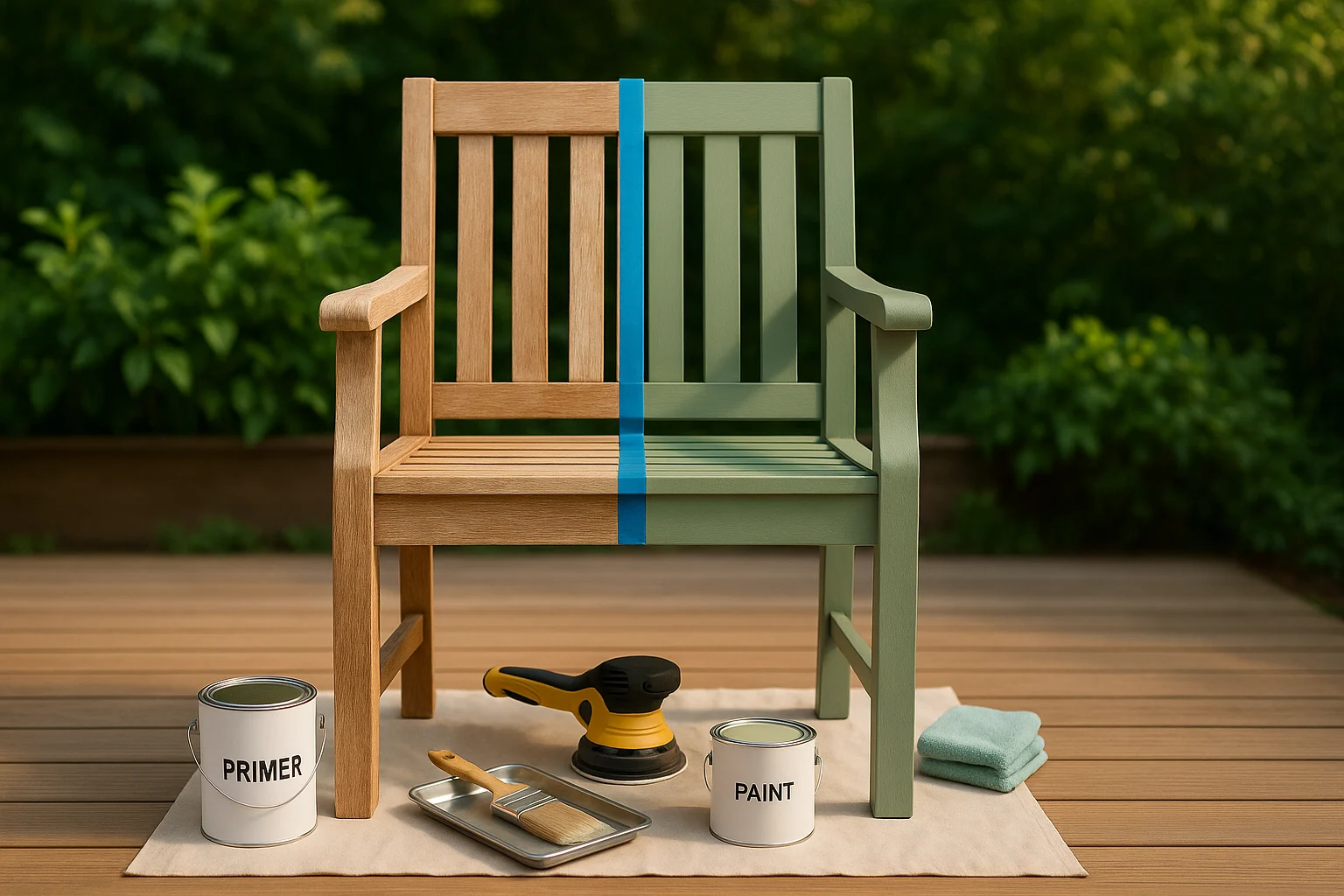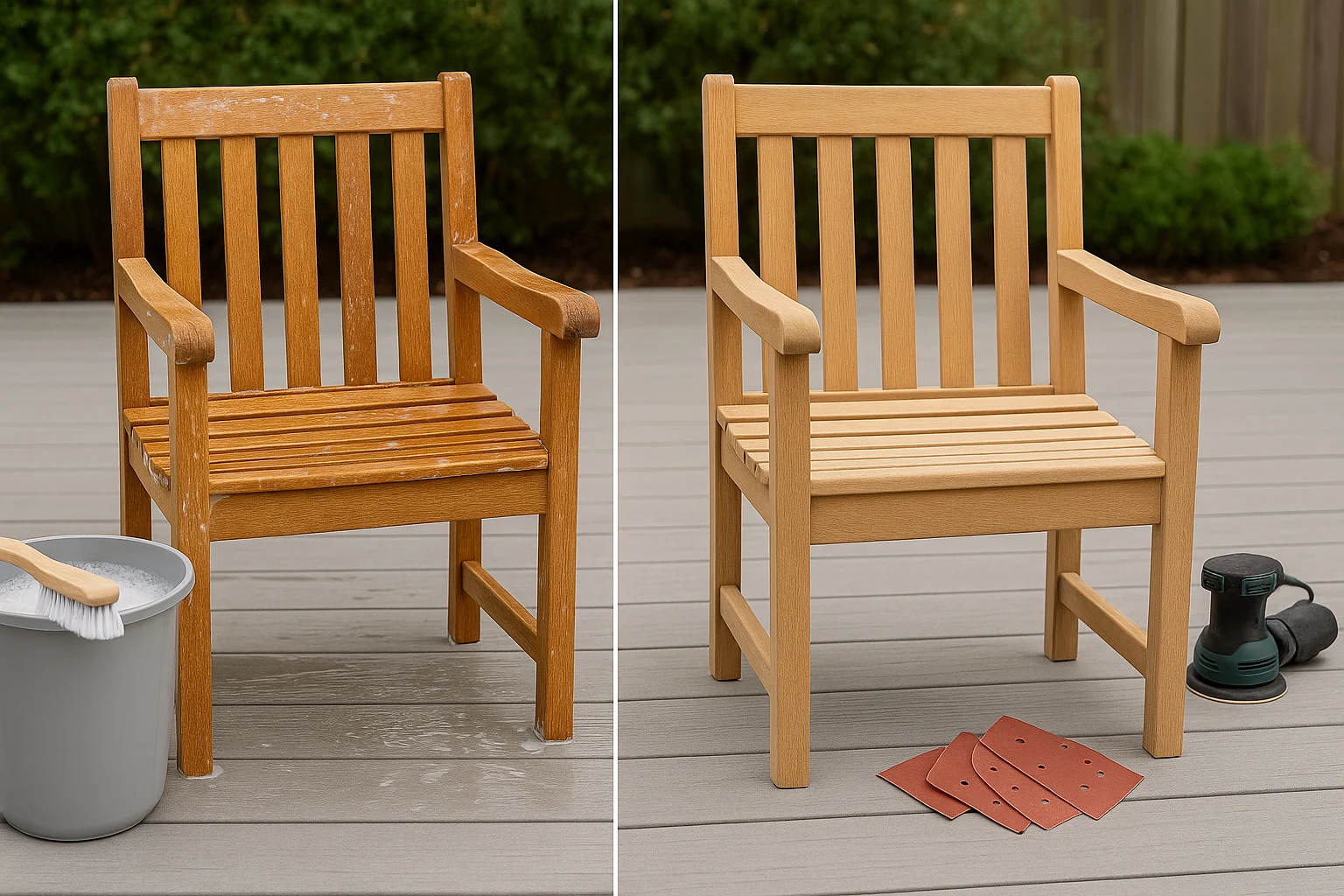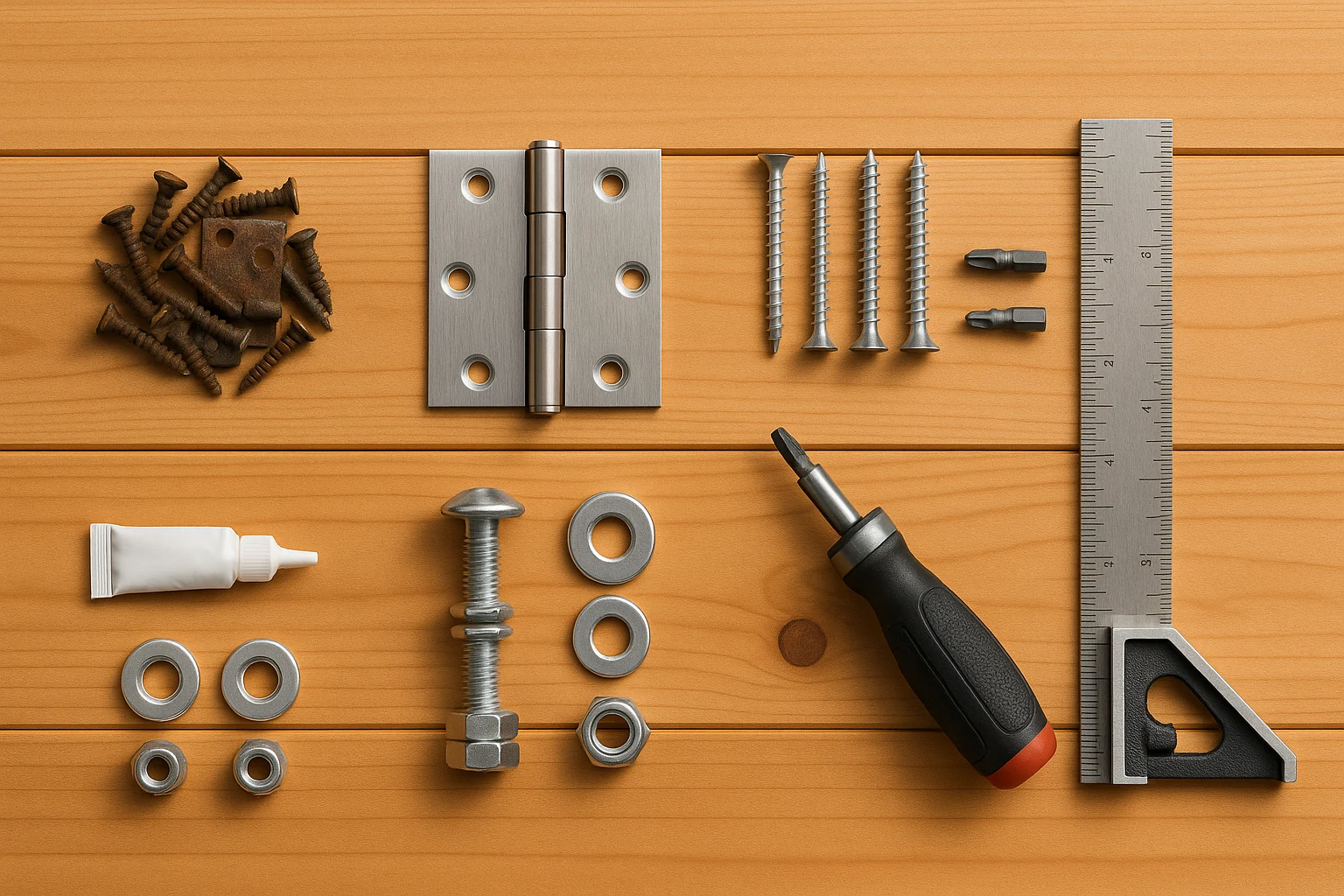
Sun-faded chairs? Don’t toss them. This weekend makeover shows how to tackle prep, prime, finish and seal so your patio pieces look new again. Most projects take 4–8 hours and about $35–$95 in materials. Our diy furniture outdoor guide keeps it simple—choose paint or stain, match the right primer to wood, metal, or plastic, and topcoat it so the finish lasts through weather.
This comprehensive guide will walk you through everything you need to know about DIY outdoor furniture makeovers. We’ll cover cleaning, degreasing, sanding, choosing between paint and stain, picking the perfect primer for wood, metal, or plastic, upgrading hardware, and adding weatherproof topcoats. Get ready to refresh your patio or deck without breaking the bank! For broader ideas, see our do it yourself home decor ideas guide.
Your Best-Fit Outdoor Furniture Makeover Tool
What’s your furniture made of?
Finish look you want?
Exposure level?
Your Best-Fit Finish Stack
💡 Thin coats cure stronger; scuff lightly between coats.
Table of Contents
- Why DIY Outdoor Furniture Makeovers? Revitalize Your Space
- Planning Your Outdoor Furniture Makeover
- Step-by-Step Makeover Guide: The Foundation of Durability
- Hardware Swaps: The Jewelry of Your Furniture
- Mini-Case Study: Patio Chair Before & After
- Safety First: Protecting Yourself and the Environment
- Maintenance Tips for Long-Lasting Outdoor Furniture
- Frequently Asked Questions
- Conclusion: Enjoy Your Revitalized Outdoor Space!
Pro move: sand lightly between coats with 220-grit and wipe dust before recoating—thin layers outlast thick ones.
Key Takeaways
- Prep first: Cleaning, degreasing, and sanding drive durability.
- Pick your finish: Paint hides flaws; stain shows grain.
- Weatherproof: Seal with a UV-resistant topcoat to resist sun and rain.
Why DIY Outdoor Furniture Makeovers? Revitalize Your Space ✨
There’s something incredibly satisfying about taking something old and making it new again. When it comes to outdoor furniture, DIY makeovers offer benefits that go beyond saving money.

Budget-Friendly Transformations
New outdoor sets are pricey. Refreshing what you own delivers a high-end look for a fraction of the cost. You’re paying for materials and a weekend, not a new set. For room-by-room ideas, browse our frugal home furnishing guide.
Sustainable & Eco-Friendly Living
Upcycling keeps furniture out of landfills and saves the resources used to make new pieces. It’s good for your budget and the planet.
Unleash Your Inner Designer
Choose bold color or a natural look—your call. Customize pieces to fit your space and style instead of settling for whatever’s in stock.
Boost Durability and Longevity
Proper prep plus exterior-grade products protect against sun and moisture so your furniture lasts longer and looks better between touch-ups.
Planning Your Outdoor Furniture Makeover
Before you grab the sander, a short plan saves time and frustration. Sketch traffic lanes before building diy deck furniture so chairs slide in and out easily.
Assessing Your Furniture: What Can Be Saved?
Check that the frame is sturdy, identify the material, and note the wear. Fading, chips, and light rust are ideal for a DIY refresh; severe rust or cracked frames may not be worth the effort.
Gathering Your Tools & Supplies
You’ll need cleaning supplies (soap, bucket, brush, gentle pressure wash, degreaser), basic repair gear (wood filler or epoxy, screwdrivers, a wire brush), sanding grits (80/120/220), and finishing products—primer matched to the material, exterior paint or stain, and a clear topcoat—plus drop cloths, tape, and trays. To stretch your budget, try these frugal cleaning hacks.
Understanding Surfaces: Wood, Metal, Plastic
Each material has quirks. Wood needs sanding and UV/moisture protection; metal needs rust removal and a DTM primer; plastic needs a light scuff and a bonding primer so paint adheres cleanly.
Project Path: Deck Furniture Plans
When you build diy deck furniture, design around how you use the deck—dining, lounging, or both—then size pieces to keep walkways clear. For deck builds you make yourself, choose rust-resistant fasteners, round over sharp edges, and seal horizontal surfaces well; they take the most sun and water. For shade over seating, consider these backyard shade ideas.
“Proper prep is 90% of a lasting finish. Skimp on the prep, and you’ll be redoing it sooner than you think!”
Step-by-Step Makeover Guide: The Foundation of Durability
Follow these steps for a pro-looking, durable finish.
Step 1: The All-Important Prep Work
Preparation drives longevity. Rushing risks peeling and early wear.
Cleaning & Degreasing (The Right Way)
Start with warm soapy water and a stiff brush; on wood, use a low-setting washer carefully. Deep-clean with a TSP substitute per the label, rinse well, and let everything dry completely.
Repairing & Filling (Small Fixes)
Tighten loose fasteners, patch cracks or holes, and sand smooth after curing. On metal, brush away rust and use a converter on pitted spots before priming.
Sanding for Success
Strip with 80–100 grit as needed, smooth with 120–150, and scuff with 220 for adhesion. Always sand with the grain and remove dust before coating.
Step 2: Choosing Your Finish – Paint vs. Stain
When to Paint
Paint hides flaws and works on multiple materials with the right primer. Choose a quality exterior acrylic; oil-based paints are durable but slower to dry and clean up.
When to Stain
Stain shows off the grain and can penetrate for moisture resistance. Pick from transparent to solid options, and add a protective clear topcoat to extend life.
Step 3: Priming for Perfection (The Adhesion Secret)
Primer bonds the surface to your topcoat, blocks stains, and adds protection. Use a stain-blocking exterior primer on wood, a DTM/rust-inhibiting primer on metal, and a plastic adhesion promoter on resin pieces. Two thin coats beat one thick one—follow dry and recoat times.
Starter Build: diy furniture pallet
Pick sound, heat-treated pallets (HT stamp), pry boards carefully, and build simple modules like a sofa base or coffee table. For pallet-wood builds, sand edges, use exterior screws, and seal end grain to slow moisture intrusion. These diy furniture pallet modules are cheap to replace if a board splits. For more backyard ideas, try these easy DIY backyard projects.
Step 4: Applying Your Paint or Stain
Techniques for a Smooth Finish
Use brushes for details, rollers on panels, and sprayers for wicker and complex shapes (after practice and masking). Apply multiple thin coats—they cure stronger and streak less. For low-cost lighting after sunset, add one of these Dollar Tree solar light projects.
Step 5: The Weatherproof Topcoat (Your Furniture’s Shield)
This final layer helps resist UV, moisture, and wear—and makes cleaning easier. Popular picks include spar urethane (flexible with UV inhibitors), UV-rated exterior clear coats, and marine varnish for the toughest conditions. Apply thin, even layers and lightly scuff between coats.
Curing vs. Drying: Water-based products may be touch-dry in 1–2 hours, light use at 24–48 hours, and fully cured near 72 hours; oils usually take longer. Conditions and product labels vary—plan for a mild, dry window.
Hardware Swaps: The Jewelry of Your Furniture
New fasteners and fittings can refresh the look and improve function. Building for pets? For a diy furniture dog crate, choose marine-grade stainless hinges and latches, add recessed pulls, and pre-drill to avoid splits. Finish metal parts with rust-inhibiting primer and paint so snag points stay smooth and weather-resistant. For enclosure layout and safety, see DIY pet cages.

Choosing the Right Materials
Stainless steel offers top corrosion resistance (use 316 near salt). Galvanized is budget-friendly but avoid deep scratches. Brass resists rust and develops patina. Skip thinly plated steel—it wears fast outdoors.
Installation Tips
Match original sizes when replacing fasteners, pre-drill to prevent splits, and add a dab of anti-seize on bolts so future adjustments are easy.
Mini-Case Study: Patio Chair Before & After
The Setup: A sun-bleached wooden chair, chipped paint, and a few rusty screws.
- Prep: Degreased, sanded 100→150 grit, wiped dust.
- Repair: Tightened joints; filled small cracks; sanded smooth.
- Prime: Exterior stain-blocking primer to prevent tannin bleed.
- Paint: Two thin coats of exterior acrylic, four hours between coats.
- Topcoat: Two satin coats of spar urethane with a light 220-grit scuff between.
- Hardware: Replaced screws with stainless equivalents.
Outcome: A bright, sturdy chair ready for seasons of use—materials ran under $40 and fit a focused weekend.
Safety First: Protecting Yourself and the Environment
DIY is fun, but safety comes first. If your home was built before 1978, assume painted surfaces may contain lead and follow lead-safe work practices or hire a certified pro. Local rules vary—check your city’s guidance on paint disposal and lead testing. Learn more about lead-safe practices.
Maintenance Tips for Long-Lasting Outdoor Furniture
Clean with mild soap and water, then rinse well. Touch up chips promptly to block moisture. Store or cover pieces during harsh winters (use breathable covers). Shade helps finishes last longer—umbrellas or pergolas make a difference. Re-seal table tops on deck-built furniture each season to keep water out. If you built a diy furniture dog crate for the porch, check latches seasonally and touch up rub spots where paws contact the finish.
Why trust this? The steps mirror best practices for exterior coatings by material (wood, metal, plastic), include lead-safe notes, and favor thin coats with full cure times for durability.
Frequently Asked Questions
Conclusion: Enjoy Your Revitalized Outdoor Space!
With a bit of planning, patient prep, and the right finish stack, you can turn tired pieces into durable favorites. Start small, learn the steps, and build up from there—your patio will thank you.
This diy furniture outdoor guide is for general education. Test for lead on pre-1978 paint, use proper PPE, and consult a qualified professional for structural repairs or safety concerns.